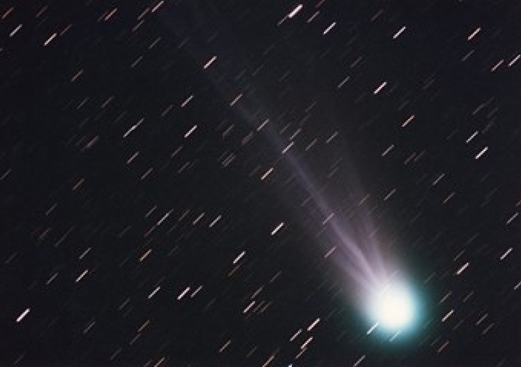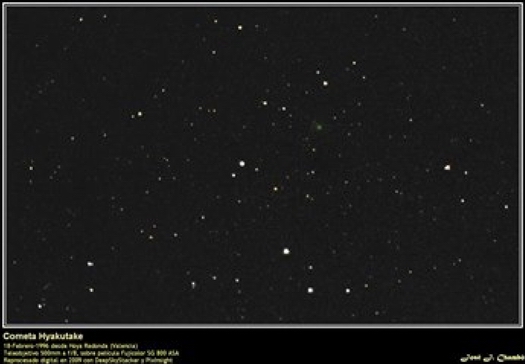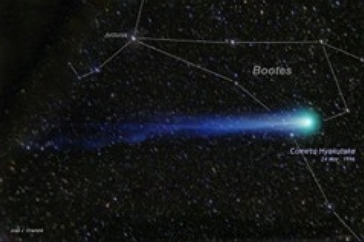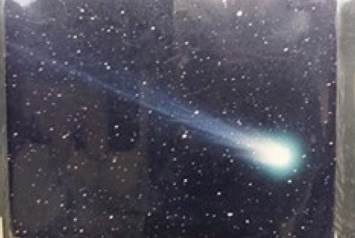Comet C/1996 B2 (Hyakutake)
The mid 1990's were an exciting time for the cometary fraternity as a bright comet was discovered in July 1995 that would shine with great beauty in the northern hemisphere skies in early 1997, its name, C/1995 01 (Hale-Bopp).
Astronomers were given ample time to plan their observing runs of a comet which, for the northern hemisphere, was the best since the predawn display of comet C/1975 V1 (West) in early 1976.
Little did we know that the next "GREAT" comet was just around the corner.
Discovery.
Our story moves to Japan and an amateur astronomer named Yuji Hyakutake. Yuji, who's surname means, a hundred Samurai, became interested in astronomy when,as a 15 year old boy, he witnessed the great comet C/1965 S1 (IkeyaSeki), this great sungrazer made him want to discover his own comet of equal greatness and the fact that this one was discovered by two Japanese observers only fuelled his enthusiasm.
He began his search in 1989 but didn't take comet hunting seriously until he left his day job as a newspaper photoengraver in 1994 and moved to Kagoshima from his home town of Hayato for clearer skies.
From July of 1994 he began by his searches by choosing a time slot of between 2 and 5 am on four nights each month using his huge 25x150 Fujinon binoculars from a mountain top 15km from his home to get better views of the Eastern horizon, on Christmas night of 1995 he struck gold.
The comet he discovered was later to be designated C/1995 Y1 (Hyakutake), an Oort cloud comet making its first and only journey into the inner Solar System. Y1 was a comet that would later go on to reach a respectable magnitude of 8.9 in March of 1996, but the best was yet to come.
The weather was not playing ball that Winter and cloudy night after cloudy night followed, but on the morning of January 31st, some 5 weeks after the discovery of Y1, and just 4 hours of searching over 2 nights during that period, he located the one that was to be the superstar.
On January 30th , he left home to reach his sight for 3.20 am, as the Moon was setting in the West. At 4am the Zenith cleared and he turned his large binoculars towards his previous discovery as it was near to M101 and NGC 5474 and noted that his comet was a little smaller than M101, magnitude 9 with an 8' coma.
At 4.20am, he came across another cometlike object whilst scanning the sky near Corvus, a familiar location to Yuji as Y1 had been in this location a few weeks prior, the new object was magnitude 11 and 2.5' in diameter and more condensed than Y1 had been.
He scrambled to mark its position at 4.50am , not believing his eyes he walked around trying to come to terms with the fact that he may have just discovered another comet in virtually the same position that he had found his first.
At 5.40 am, he went back to the binoculars as twilight began, to check for any motion of the object, none was noted, but Yuji concluded that the object was heading straight at us.
He went home to check for new discoveries and found none and so sent a report to Syiichi Nakano and at 3am the following morning it was confirmed that he had discovery number two and it was designated, C/1996 B2 (Hyakutake).
Orbit.
As with all discoveries , the next step is to calculate the orbit and the good news was that B2 had passed within the inner Solar System before some 17,000 years prior and traversed a large elliptical orbital path, best imagined as an inch wide and 4 feet long, with perihelion at 0.23 AU from the Sun and aphelion laying at some 1,300 AU from the Sun in the direction of the constellation of Pyxis. That was the perihelion passage of 1996 but the planets have stretched the orbit somewhat so that now perihelion is around the same distance but aphelion now reaches out to 4543 AU, touching the inner Oort cloud area.
Apparition.
The comet at discovery was 2 AU from the Sun and 1.88 AU from the Earth. In early February the comet was magnitude 9 with a 6.5' coma which equates in real size to 300,000 km, by midmonth the comet was naked eye.
On March 12th it crossed to the northern side of our orbit and was rising at sunset in Bootes. It moved swiftly, passing through Draco then Ursa Major and reaching 0 magnitude on the 24th .On the 25th of March it was just 0.1018 AU from Earth, 40x the distance from Earth to Moon, and the nearest cometary approach to Earth since 1983.
Perihelion occured on May 1st at 0.230 AU with the comet rounding the Sun at 88 km/s. Five days later it dived below the ecliptic .
The tail was intricate and long, reaching 50 deg on March 25th, but from a dark location was up to 100 deg long, of which I myself saw the tail this long.Japanese astronomers noted a knot in the tail that was travelling at 100 km/s and the coma was 0.8 mag and 1.5 deg across between Polaris and Ursa Major,the ion tail stretching across the handle and moving at 1 deg an hour.
After this the comet began to fade slowly as it moved away from Earth and didn't brighten as it approached perihelion.
The comet moved into southern skies after this and remained a naked eye object until June with a 6' coma.
By July it was mag 7, by August mag 8 and by September 1st, mag 11. Last photographs taken of it that year in October showed it to be stellar-like, no coma and mag 17.
Orbital Characteristics.
q = 0.230 AU, 1/5/96
Aphelion= 4543.9 AU
e = 0.99989
i = 124.922 deg
Dimensions= 2.1 km
Rotation= 6 hours.
MOID= 0.100969.
Absolute magnitude= 7.3.
Images kindly and greatly appreciated provided by Ron Knight, Kevin Parker, Grant Blair, José J. Chambó Bris.





Neil Norman.
Ipswich. England.
back